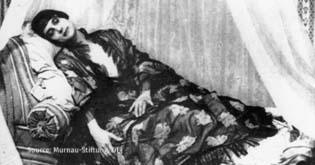A respected doctor abandons his fiancée for a naive and lascivious dancer and moves with her to the stormy sea. As a country doctor, he also gives sight to a mysterious blind painter. At the first glance of the healed man with the dancer, the two fall for each other in irrepressible passion. Years later the doctor is a successful specialist in ophthalmology, but internally broken by experience. When the painter threatens to go blind again, the dancer asks the doctor to restore his sight. The doctor takes revenge in the heat of passion by demanding her suicide as a price. At her deathbed the painter refuses another eye treatment.
Friedrich Wilhelm Murnau belongs beside Fritz Lang and G. W. Pabst to the most important directors of the early German film. His NOSFERATU. A SYMPHONY OF HORROR (1922) taught generations of cinema-goers that this was something to fear, his THE LAST MAN (1924) revolutionized cinema in the mobility of the camera, his FAUST. EINE DEUTSCHE VOLKSSAGE (1926) set trick technical standards and with his American production SUNRISE he even got the highest of all honours in 1927: the Oscar for the best film. It is therefore all the more surprising that the director’s first six films have gone missing. The earliest surviving film, DER GANG DURCH DIE NACHT (1921) has received little attention in recent decades. Unjustly, as it now turns out.
The 2015/2016 version, reconstructed and digitally restored by the Munich Film Museum, shows an amazingly sovereign Murnau film. More unobtrusive and not so effect-hunting, but stylistically closed and impressively played. The script of the legendary “film author” Carl Mayer bears in its five acts traits of ancient dramas, thoughtfully constructed in the contrast between city and country as well as between the bourgeois milieu of a doctor and the passionate world of a dancer.
Murnau is influenced by the once so popular masterpieces of the Scandinavian silent film and in his pictorial language he also takes up motives of a Caspar David Friedrich again and again. The storm-whipped sea becomes the essential protagonist of a coastal landscape, which nestles sweetly around love scenes or cruelly accompanies the inescapable fate. Murnau’s film montage is also fateful: in the alternation of play scenes and nature shots, psychological states are revealed and the film is structured narratively. The pictures are skilfully composed and the interiors remarkably illuminated: Discreet and impressionistic are the lines of the boudoirs and contrasting and expressionistic are the dark and gloomy country house scenes. Wet asphalt, how he made the “last man” disappear in deep nightly street canyons, already sounds here. In general, in GANG IN DIE NACHT there are important points of reference for Murnau’s further work.
Text by Richard Siedhoff.

